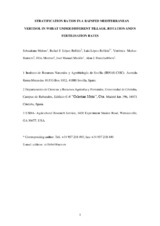Mostrar el registro sencillo del ítem
Stratification ratios in a rainfed Mediterranean Vertisol in wheat under different tillage, rotation and N fertilisation rates
| dc.contributor.author | Melero, Sebastiana | |
| dc.contributor.author | López-Bellido Garrido, Rafael J. | |
| dc.contributor.author | López Bellido, Luis | |
| dc.contributor.author | Muñoz-Romero, Verónica | |
| dc.contributor.author | Moreno, Félix | |
| dc.contributor.author | Murillo, J.M. | |
| dc.contributor.author | Franzluebbers, Alan J. | |
| dc.date.accessioned | 2024-01-11T10:26:30Z | |
| dc.date.available | 2024-01-11T10:26:30Z | |
| dc.date.issued | 2012 | |
| dc.identifier.issn | 1879-3444 | |
| dc.identifier.uri | http://hdl.handle.net/10396/26503 | |
| dc.description.abstract | Semiarid Mediterranean climatic conditions and intensive tillage systems accelerate soil organic matter losses. Therefore, assessing agricultural practices that enhance storage of soil organic matter is needed. Stratification of soil properties with soil depth, expressed as a ratio, could indicate soil quality under different soil management. We measured soil depth stratification ratio (0–5/10–30 cm and 0–5/30–50 cm) of soil organic C (SOC), total N, active carbon (AC), water soluble carbon (WSC), and soil enzymatic activities [dehydrogenase activity (DHA) and β-glucosidase activity (BGA)] of a Typic Haploxerert in southern Spain. The experimental design consisted of a split–split plot design with three replications and soil properties evaluated at the end of 22 years. Tillage systems included conventional tillage (CT) and no tillage (NT). Dryland, 2-year crop rotations were wheat (Triticum aestivum L.)–fallow (WF), wheat–chickpea (Cicer arietinum L.) (WC), wheat–faba bean (Vicia faba L.) (WFb), wheat–sunflower (Helianthus annuus L.) (WS), and continuous wheat (WW). Nitrogen fertiliser rates were 0, 50 and 150 kg N ha−1. Stratification ratios of total N, WSC, AC, DHA, and BGA were most responsive to tillage systems; NT greater than CT. Stratification ratios of SOC, total N, WSC, AC and BGA were most responsive to crop rotation; WFb and WW greater than WF, WC, and WS. Stratification ratio of BGA was most responsive to N fertiliser rate; higher rates than no fertiliser. Stratification ratios of C and N fractions and enzymatic activities were responsive to choice of denominator used for ratio calculation. Tillage and crop rotation had more influence than N fertiliser rate in affecting stratification ratio of C and N fractions and enzymatic activities. Stratification ratio was relatively low (<2), perhaps due to the large shrinking and swelling characteristics of Vertisols. Stratification ratio of BGA was greater than of all other soil properties, suggesting that it might be a good indicator of soil quality under different soil management in Mediterranean conditions, particularly with Vertisols. This study indicated the value of stratification ratios to detect improvement in soil organic matter fractions and enzymatic activities (i.e. indicators of soil quality) with adoption of improved conservation management approaches. | es_ES |
| dc.format.mimetype | application/pdf | es_ES |
| dc.language.iso | eng | es_ES |
| dc.publisher | Science Direct | es_ES |
| dc.rights | https://creativecommons.org/licenses/by-nc-nd/4.0/ | es_ES |
| dc.source | Soil and Tillage Research; Vo 119, Pages 7-12 (2012) | es_ES |
| dc.subject | Dryland agriculture | es_ES |
| dc.subject | Clay | es_ES |
| dc.subject | Soil organic matter | es_ES |
| dc.subject | Conservation tillage | es_ES |
| dc.subject | Enzymatic activities | es_ES |
| dc.title | Stratification ratios in a rainfed Mediterranean Vertisol in wheat under different tillage, rotation and N fertilisation rates | es_ES |
| dc.type | info:eu-repo/semantics/article | es_ES |
| dc.relation.publisherversion | https://doi.org/10.1016/j.still.2011.11.012 | es_ES |
| dc.relation.projectID | Gobierno de España. AGL2010-22050-C03-03 | es_ES |
| dc.relation.projectID | Gobierno de España. AGL2006-02127 | es_ES |
| dc.rights.accessRights | info:eu-repo/semantics/openAccess | es_ES |

